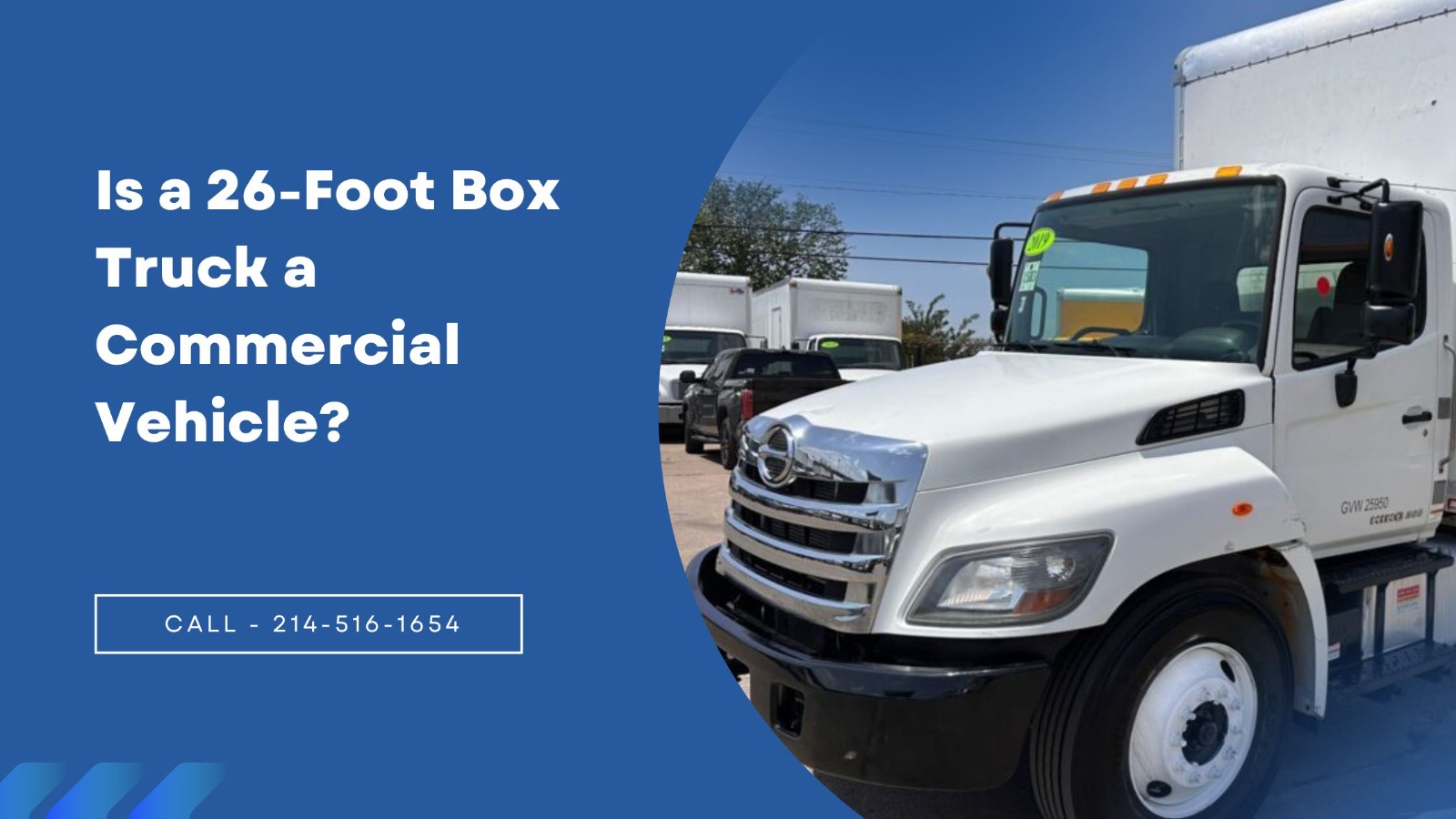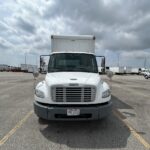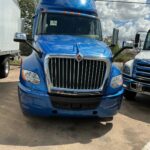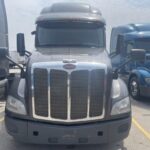

Is a 26-Foot Box Truck a Commercial Vehicle
Ever wondered if a 26 foot box truck counts as a commercial vehicle? You’re not alone. Many new business owners, delivery drivers and renters ask this before getting behind the wheel. Between CDL rules, DOT regulations and insurance laws, it can feel confusing.
At RK Truck Sales in Dallas, Texas, we specialize in 26 foot box trucks for sale including Hino, International and Freightliner 26 foot box trucks and we’re here to explain everything clearly.
What Is a 26 Foot Box Truck?
A 26 foot box truck (sometimes called a 26-footer box truck or box truck 26 foot) is one of the largest non-CDL trucks you can drive. It’s the bridge between small delivery vans and full-size semi-trucks.
Most 26 foot box trucks feature:
- Cargo space: 26 feet long, about 8 feet wide and 8–9 feet high
- Payload capacity: around 10,000 pounds
- GVWR (Gross Vehicle Weight Rating): up to 26,000 pounds
These trucks are ideal for:
- Moving furniture or appliances
- Delivering freight and bulk goods
- Regional and local business deliveries
You can find various models, including a 26 foot box truck with liftgate for sale, 26 foot box truck with sleeper and new 26 foot box truck for sale options at RK Truck Sales.
26 Foot Box Truck Dimensions & Capacity
Understanding 26 foot box truck dimensions helps ensure you’re picking the right truck for your needs.
| Specification | Typical Range |
| Length | 26 feet |
| Width | 8–8.5 feet |
| Height | 8–9 feet |
| Interior Volume | 1,600–1,800 cubic feet |
| Payload Capacity | 9,000–10,000 lbs |
| GVWR | 25,999–26,000 lbs (Non-CDL limit) |
Pro Tip: Always check the manufacturer’s plate for GVWR, it determines whether you’ll need a CDL.
Is a 26 Foot Box Truck a Commercial Vehicle?
Yes, a 26-foot box truck is typically a commercial vehicle. The classification depends on use and weight:
- If you use your truck for business deliveries, freight hauling or logistics, it’s commercial.
- Even if used personally, insurance and DOT may still classify it as a commercial truck due to its GVWR and weight capacity.
Whether it’s a 26 foot Freightliner box truck, International 26 foot box truck or Hino 26 foot box truck for sale, all fall under the same rules when used commercially.
How Much Does a 26 Foot Box Truck Weigh?
- Empty Weight: ~12,000–13,000 lbs (varies by model)
- GVWR: 26,000 lbs (maximum allowed for non-CDL)
- Payload Capacity: ~9,000–10,000 lbs
So, how much does a 26-foot box truck weigh empty? Typically between 12,000 and 14,000 pounds depending on engine type, liftgate and box materials.
Wondering how much weight can a 26 foot box truck carry? Most can safely carry around 10,000 pounds of cargo.
26 Foot Box Truck CDL Requirements
Here’s the key rule:
- No CDL Required if the GVWR ≤ 26,000 lbs
- CDL Required if GVWR ≥ 26,001 lbs
This makes most 26 foot box trucks for sale classified as 26 foot box trucks non-CDL perfect for small business owners or delivery drivers without a commercial license.
However, 26 foot box trucks with liftgate or 26 foot box trucks with sleeper can weigh slightly more, so always check the rating before purchase.
When You Need a CDL for a 26-Foot Box Truck
You’ll need a Class B CDL if:
- GVWR exceeds 26,001 lbs
- You’re towing over 10,000 lbs
- You’re hauling hazardous materials
This applies to heavier configurations like a Freightliner 26 foot box truck with lift gate or custom trucks with large sleepers.
DOT Regulations for 26 Foot Box Trucks
Even if a CDL isn’t required, DOT rules still apply for commercial operations. You may need to:
- Keep a driver’s logbook for long hauls
- Conduct daily vehicle inspections
- Follow hours-of-service (HOS) rules
Non-compliance can lead to DOT fines or being placed out of service.
26-Foot Box Truck Insurance Cost
Insurance for a 26-foot box truck depends on:
- Driving history
- Truck value and model
- Cargo type
- Route distance
On average, 26-foot box truck insurance cost ranges from $400–$800/month for liability and cargo coverage. Larger trucks with liftgates or sleepers may cost slightly more.
Popular Models & Configurations
- Hino 26 foot box truck for sale – Durable, reliable, great MPG
- Freightliner 26 foot box truck – Built for comfort and efficiency
- International 26 foot box truck – Proven for long-haul and regional delivery
- 26 foot box truck with liftgate for sale – Ideal for heavy loading/unloading
- Used 26 foot box truck with sleeper for sale – Perfect for overnight routes
You can explore 26 foot box trucks for sale near Dallas in various specs with lift gates, sleepers or non-CDL ratings.
26 Foot Box Truck MPG & Load Boards
- Average MPG: 8–12 miles per gallon (depending on load, terrain, and engine)
- Best Use: Short-haul and local delivery routes
- You can find available jobs and contracts through 26 foot box truck load boards, perfect for owner-operators managing small fleets.
Who Uses 26 Foot Box Trucks?
You’ll commonly see 26-foot box trucks used by:
- Moving and storage companies
- Retail chains and furniture delivery
- Independent freight drivers
- Rental agencies offering 26 foot box truck rental
Many prefer 26 foot box trucks with lift gates for quick loading, while long-haul drivers opt for 26 foot box trucks with sleeper for sale setups.
Common Myths About 26 Foot Box Trucks
- “All 26-foot trucks need a CDL.”
Only those over 26,001 lbs GVWR require a CDL. - “Weight doesn’t matter.”
It does, your compliance depends entirely on the GVWR, not the truck’s length. - “Personal use exempts you from DOT rules.”
DOT can still apply based on weight and operation type.
Safety Tips for First-Time Drivers
If you’re new to operating a 26 foot box truck, the jump from a pickup or van can be intimidating. These trucks are significantly larger, heavier, and require more awareness on the road. Whether you’ve just bought a used 26 foot box truck for sale, rented one for a move, or are starting a delivery job with a 26 foot box truck with liftgate, following a few key safety habits can make all the difference.
Below are essential safety tips to help you stay confident and compliant behind the wheel of your 26 foot box truck:
- Check and Adjust Your Mirrors and Blind Spots
A 26 foot box truck has much larger blind spots than smaller vehicles. You can’t rely solely on your rearview mirror because the cargo box completely blocks your rear view.
Before driving, always:
- Adjust side mirrors to minimize blind zones.
- Use wide-angle mirrors if available for better visibility.
- Check both sides before changing lanes or merging.
- Use a spotter or backup camera if reversing in tight spaces.
This is especially important when maneuvering 26 foot box trucks with liftgate or 26 foot box trucks with sleeper, since additional equipment can reduce visibility even more.
2. Make Wider, Slower Turns
Because of their length and turning radius, 26-foot box trucks need extra room for turns, especially right-hand ones. Cutting corners too sharply can cause the truck’s rear wheels to hop curbs, clip poles or even strike other vehicles.
Always:
- Approach turns slowly and use your mirrors.
- Swing slightly wider to keep the rear wheels clear.
- Watch for pedestrians, parked cars, and obstacles.
Practicing in an open parking lot before hitting busy roads can help new drivers get used to the 26 foot box truck dimensions and turning clearance.
3. Conduct a Full Pre-Trip Inspection
Every trip should start with a quick but thorough safety inspection. It’s not just good practice, it’s a DOT requirement for commercial vehicles, including 26 foot box trucks used for business.
Check the following before starting your route:
- Tires: Look for proper inflation and tread depth.
- Brakes: Test stopping distance and pedal firmness.
- Lights: Ensure headlights, brake lights and turn signals all work.
- Mirrors and wipers: Keep them clean for clear visibility.
- Fluids: Check oil, coolant and windshield washer levels.
If you’re driving a Freightliner 26 foot box truck or Hino 26 foot box truck for sale, always follow the manufacturer’s inspection checklist, especially if you’re operating in extreme heat or cold.
4. Plan Your Route in Advance
Unlike smaller vehicles, 26 foot box trucks can’t take every route. Low bridges, narrow roads, and weight-restricted areas can quickly turn into costly mistakes.
Before hitting the road:
- Use a commercial GPS or truck-specific navigation app.
- Avoid low clearance bridges and tight city alleys.
- Know your truck height and weight (usually around 13 feet high and 26,000 lbs GVWR).
- Identify safe parking and loading zones near your delivery points.
Planning is especially important if you’re driving a 26 foot box truck with sleeper, as these models may have slightly taller profiles. Route planning saves time, fuel, and reduces the risk of fines or accidents.
5. Secure Your Cargo Properly
Unsecured cargo is one of the top causes of box truck accidents and damage claims. A 26 foot box truck can carry up to 10,000 pounds of cargo and any shift in that weight can make the vehicle unstable during braking or turning.
Always:
- Use ratchet straps, load bars, and cargo nets to secure freight.
- Distribute weight evenly across the floor to avoid leaning.
- Keep heavy items low and toward the front of the box.
- Check tie-downs after the first few miles of driving.
If you’re using 26 foot box truck load boards to find freight jobs, double-check the cargo details so you can bring proper securing equipment for every haul.
6. Maintain Safe Following Distance
A fully loaded 26-foot box truck takes much longer to stop than a car or SUV, often double the distance. Maintain at least five to six seconds of space between you and the vehicle ahead. If the road is wet, icy or downhill, increase that gap even more. Sudden stops in a 26 foot used box truck for sale with heavy cargo can cause skidding or jackknifing. Smooth braking and steady acceleration will help you stay in control.
7. Stay Aware of Height and Weight Restrictions
Many 26 foot box trucks stand over 12–13 feet tall, so it’s critical to avoid low overpasses, parking garages, and bridges with clearance limits. Always look for posted clearance signs, especially when driving in unfamiliar areas.
8. Practice Parking and Reversing
Parking a 26 foot box truck can be one of the toughest challenges for new drivers. These trucks require more space, and visibility is limited.
Tips for safer parking:
- Back into spaces slowly with the aid of mirrors or a spotter.
- Avoid tight parking lots or areas with low-hanging branches.
- Use hazard lights when reversing in public areas.
If your truck has a rear-view camera or parking assist, use it, but don’t rely on it alone. Practice makes perfect when handling a 26 foot Freightliner box truck or International 26 foot box truck in tight delivery zones.
9. Drive Defensively and Avoid Distractions
Commercial box trucks require full attention, distractions can have severe consequences due to size and weight.
Stay safe by:
- Keeping your phone on silent or using hands-free mode.
- Watching for smaller vehicles in your blind spots.
- Anticipating lane changes and braking early.
Remember, even a small mistake in a 26 foot box truck can cause significant damage, so staying alert is crucial, especially in city traffic.
10. Take Breaks and Know Your Limits
Long days behind the wheel can lead to fatigue, especially for new drivers. Always schedule regular rest breaks, stretch your legs and stay hydrated.
If you drive a 26 foot box truck with sleeper for sale, use the sleeper berth for rest periods when on long hauls. Fatigue is a leading cause of commercial vehicle accidents, never push beyond your limits.
Conclusion
So, is a 26-foot box truck a commercial vehicle? Yes, in most cases, it is. Its size, GVWR and business use make it commercial by definition. Whether you need a CDL depends on the 26,001-lb GVWR rule.
At RK Truck Sales, we make it easy to find used 26 foot box trucks for sale, 26 foot box trucks with liftgate for sale, or new 26 foot box trucks for sale that fits your business whether you’re starting out or expanding your fleet.
Frequently Asked Questions
Q1: Is a 26 foot box truck a commercial vehicle?
Yes, a 26 foot box truck is typically classified as a commercial vehicle because of its size, weight, and business use. Any truck used to haul goods, equipment, or deliveries for profit automatically falls under the commercial vehicle category according to both federal and state DOT regulations.
Q2: Do you need a CDL for a 26 foot box truck?
In most cases, no you do not need a CDL to drive a 26 foot box truck as long as the GVWR is 26,000 pounds or less.
That’s why many box trucks are manufactured just under the CDL threshold, making them ideal for non-CDL commercial use. These are often labeled as 26 foot box truck non-CDL or 26 foot box trucks for sale under CDL limit.
Q3: How much does a 26 foot box truck weigh?
A 26 foot box truck typically weighs between 12,000 and 14,000 pounds empty (also called the curb weight). When fully loaded, the gross vehicle weight rating (GVWR) usually reaches 26,000 pounds, the legal limit before a CDL is required.
Q4: What’s the average 26 foot box truck MPG?
The average 26 foot box truck MPG typically ranges from 8 to 12 miles per gallon, depending on the engine type, load weight, driving conditions, and terrain.
Here’s a general breakdown:
- Light loads or empty → 11–12 MPG
- Medium loads (~5,000 lbs) → 9–10 MPG
- Fully loaded (up to 10,000 lbs) → 7–8 MPG
Diesel-powered trucks like the Freightliner 26 foot box truck or International 26 foot box truck are more fuel-efficient and durable for long-haul routes. Drivers can improve fuel economy by maintaining tire pressure, limiting idle time, and planning efficient delivery routes. If you’re looking for a fuel-efficient 26 foot box truck for sale, RK Truck Sales Dallas offers a range of diesel-powered and aerodynamic models to help lower your operating costs.
Q5: How much weight can a 26 foot box truck carry?
Most 26 foot box trucks can carry 9,000 to 10,000 pounds of payload, depending on the make and model.
To calculate how much weight you can haul:
Payload Capacity = GVWR – Empty Truck Weight
Q6: What is the insurance cost for a 26-foot box truck?
The 26-foot box truck insurance cost depends on several factors, your driving record, business type, route distance and cargo value. On average, commercial box truck insurance ranges between $400 and $800 per month for liability and cargo coverage. Some fleets may pay more for comprehensive coverage that includes:
Add a comment Cancel reply
Comments (0)
Recent Posts
About us

John Hendricks is a commercial truck enthusiast and content writer for RK Truck Sales. With a deep understanding of the trucking industry and market trends, John Hendricks specializes in educating visitors on used and new box trucks. When he’s not writing, you’ll find him visiting truck lots or chatting with industry pros across Dallas.
Related posts








